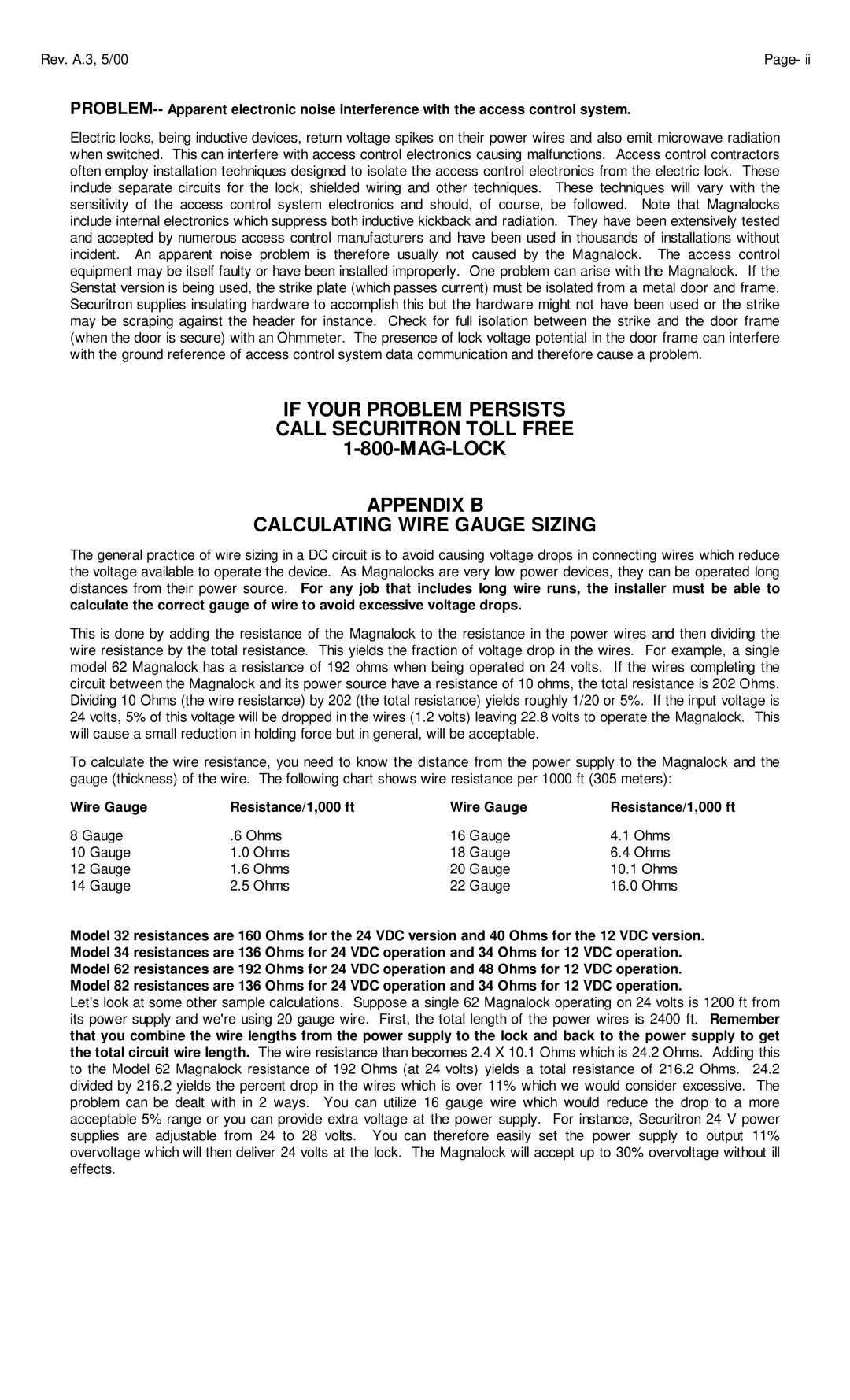Rev. A.3, 5/00 | Page- ii |
Electric locks, being inductive devices, return voltage spikes on their power wires and also emit microwave radiation when switched. This can interfere with access control electronics causing malfunctions. Access control contractors often employ installation techniques designed to isolate the access control electronics from the electric lock. These include separate circuits for the lock, shielded wiring and other techniques. These techniques will vary with the sensitivity of the access control system electronics and should, of course, be followed. Note that Magnalocks include internal electronics which suppress both inductive kickback and radiation. They have been extensively tested and accepted by numerous access control manufacturers and have been used in thousands of installations without incident. An apparent noise problem is therefore usually not caused by the Magnalock. The access control equipment may be itself faulty or have been installed improperly. One problem can arise with the Magnalock. If the Senstat version is being used, the strike plate (which passes current) must be isolated from a metal door and frame. Securitron supplies insulating hardware to accomplish this but the hardware might not have been used or the strike may be scraping against the header for instance. Check for full isolation between the strike and the door frame (when the door is secure) with an Ohmmeter. The presence of lock voltage potential in the door frame can interfere with the ground reference of access control system data communication and therefore cause a problem.
IF YOUR PROBLEM PERSISTS CALL SECURITRON TOLL FREE
APPENDIX B
CALCULATING WIRE GAUGE SIZING
The general practice of wire sizing in a DC circuit is to avoid causing voltage drops in connecting wires which reduce the voltage available to operate the device. As Magnalocks are very low power devices, they can be operated long distances from their power source. For any job that includes long wire runs, the installer must be able to calculate the correct gauge of wire to avoid excessive voltage drops.
This is done by adding the resistance of the Magnalock to the resistance in the power wires and then dividing the wire resistance by the total resistance. This yields the fraction of voltage drop in the wires. For example, a single model 62 Magnalock has a resistance of 192 ohms when being operated on 24 volts. If the wires completing the circuit between the Magnalock and its power source have a resistance of 10 ohms, the total resistance is 202 Ohms. Dividing 10 Ohms (the wire resistance) by 202 (the total resistance) yields roughly 1/20 or 5%. If the input voltage is 24 volts, 5% of this voltage will be dropped in the wires (1.2 volts) leaving 22.8 volts to operate the Magnalock. This will cause a small reduction in holding force but in general, will be acceptable.
To calculate the wire resistance, you need to know the distance from the power supply to the Magnalock and the gauge (thickness) of the wire. The following chart shows wire resistance per 1000 ft (305 meters):
Wire Gauge | Resistance/1,000 ft | Wire Gauge | Resistance/1,000 ft |
8 Gauge | .6 Ohms | 16 Gauge | 4.1 Ohms |
10 Gauge | 1.0 Ohms | 18 Gauge | 6.4 Ohms |
12 Gauge | 1.6 Ohms | 20 Gauge | 10.1 Ohms |
14 Gauge | 2.5 Ohms | 22 Gauge | 16.0 Ohms |
Model 32 resistances are 160 Ohms for the 24 VDC version and 40 Ohms for the 12 VDC version. Model 34 resistances are 136 Ohms for 24 VDC operation and 34 Ohms for 12 VDC operation. Model 62 resistances are 192 Ohms for 24 VDC operation and 48 Ohms for 12 VDC operation. Model 82 resistances are 136 Ohms for 24 VDC operation and 34 Ohms for 12 VDC operation.
Let's look at some other sample calculations. Suppose a single 62 Magnalock operating on 24 volts is 1200 ft from its power supply and we're using 20 gauge wire. First, the total length of the power wires is 2400 ft. Remember that you combine the wire lengths from the power supply to the lock and back to the power supply to get the total circuit wire length. The wire resistance than becomes 2.4 X 10.1 Ohms which is 24.2 Ohms. Adding this to the Model 62 Magnalock resistance of 192 Ohms (at 24 volts) yields a total resistance of 216.2 Ohms. 24.2 divided by 216.2 yields the percent drop in the wires which is over 11% which we would consider excessive. The problem can be dealt with in 2 ways. You can utilize 16 gauge wire which would reduce the drop to a more acceptable 5% range or you can provide extra voltage at the power supply. For instance, Securitron 24 V power supplies are adjustable from 24 to 28 volts. You can therefore easily set the power supply to output 11% overvoltage which will then deliver 24 volts at the lock. The Magnalock will accept up to 30% overvoltage without ill effects.
